Doctor, Your Patient
Will See You Now
Doctor, Your Patient Will See You Now
Gaining the Upper Hand
in Your Medical Care
Steven Z. Kussin, M.D.
ROWMAN & LITTLEFIELD PUBLISHERS, INC.
Lanham Boulder New York Toronto Plymouth, UK
Published by Rowman & Littlefield Publishers, Inc.
A wholly owned subsidiary of The Rowman & Littlefield Publishing Group, Inc.
4501 Forbes Boulevard, Suite 200, Lanham, Maryland 20706
http://www.rowmanlittlefield.com
Estover Road, Plymouth PL6 7PY, United Kingdom
Copyright 2011 by Rowman & Littlefield Publishers, Inc.
All rights reserved . No part of this book may be reproduced in any form or by any electronic or mechanical means, including information storage and retrieval systems, without written permission from the publisher, except by a reviewer who may quote passages in a review.
British Library Cataloguing in Publication Information Available
Library of Congress Cataloging-in-Publication Data
Kussin, Steven Z., 1949
Doctor, your patient will see you now : gaining the upper hand in your medical care / Steven Z. Kussin.
p. cm.
Includes bibliographical references and index.
ISBN 978-1-4422-1059-2 (cloth : alk. paper) ISBN 978-1-4422-1061-5 (electronic)
1. Physician and patientPopular works. 2. Patient educationPopular works. 3. Medical carePopular works. I. Title.
R727.3.K88 2011
610.696--dc22
2010052668
 The paper used in this publication meets the minimum requirements of American National Standard for Information SciencesPermanence of Paper for Printed Library Materials, ANSI/NISO Z39.48-1992.
The paper used in this publication meets the minimum requirements of American National Standard for Information SciencesPermanence of Paper for Printed Library Materials, ANSI/NISO Z39.48-1992.
Printed in the United States of America
For Dad
&
Annie, the blood in my heart
Zach and Efrem, the breath in my lungs
One and the selfsame tongue first wounded me,
So that it tinged the one cheek and the other,
And then held out to me the medicine;
Dante Alighieri, The Divine Comedy ,
Canto XXXI
Preface
The Process of Caring
Annie drove us home that night on a Decembers winter road. We passed homes, dappled in Christmas lightsstudies in pointillism fragmenting the monochrome of our central New York winter. I slept undisturbed, insulated in the warmth and quiet of an SUV large enough to forgive the faults of a country road.
Awakened by Annies warning, I saw but did not register the portent of the two lights shining in our windshield. Christmas lights? No, oncoming headlightsclosing fast. Then, the sudden stop. A neck-snapping, inertia-defying, absolute deceleration. The explosion of noise. The vacuum of total silence. The freezing cold. All in a time too brief to measure. Dazed and detached, there was no pain, no fear, no concerns for Annie or myself. I only wondered how it could be possible for things to change so suddenly, so completely.
Then the pain. How could I breathe? Was my chest crushed against the seat belt? The dashboard? Then the panic. I stepped from the car on my ruined leg, the top of my tibia no more than a powder. Breathing at last, I belatedly remembered that Annie was with me. Phone in hand, bleeding from her nose, she had already called 911, and she told me she was okay. But I saw in her eyes that I wasnt. Days later we learned that she wasnt either (nerve damage to her leg). Few people escape this type of accident unscathed. The teenager in the other car was medevacked to a destination unknown. She lived. She lives. Thats all I know.
I knew my leg was broken before the ambulance got the call. I was, and am, a doctor. Without the need of advanced diagnostic skills, the facts were clear. Bone edge pushed up under the skin beneath my right knee. My hands were swollen and had already taken on a mottled lividity. They too were broken. From the car to the ambulance to the emergency room, as the world went by horizontally, I was nothing more than a package. Not just any bundle, but a special delivery package that was treated as gently and urgently as a fragile but overdue birthday gift.
Now it was my turn to lie on a stretcher in the emergency room. I remember that my eyes fixed on the gypsum tiles on the suspended ceiling above me. I absently counted the small holes on those stained tiles. I counted the dimples on patterns I created: concentric circles, diagonals, triangles, and rhomboids. Yes, yes, I was stoned. I lay there with a false spiritual fillip empowered by morphine and lingering shock. This was my first patient-oriented perspective on hospital lifelying down, strung out, looking up and counting.
I was still sufficiently sensate to be aware of, and comforted by, the fact that, because I was a doctor, everybody who was about to attend to my care was going to be careful, mannered, and responsive to my questions. Not so for my litter mate next door. My separation from him was far greater than the flimsy curtain that hung between us.
The motor vehicle accident that put me on that gurney was not a threat to life and limbjust my limbs. But it did end my thirty years in clinical practice. I underwent several surgeries and spent months in a wheelchair with both hands and one leg immobilized, followed by a prolonged rehabilitation. During those months I replayed my very bad ride on that winter road and my very privileged ride on the rails of a medical system that received me as an equal.
My doctors were, or became, friends; yours, most likely, wont. Each of my physicians was chosen by me, decisions empowered by my long experience with them and the certain and comfortable knowledge of their professional and personal lives. You are not likely to have that opportunity. Despite even these advantages, mistakes were made. Most were harmless; one wasnt. I recognized the errors that you wouldnt. (Nor would it be as likely that youd be informed of them.) Most medical mistakes will fly beneath your radar, affecting your recovery but not preventing it.
Imagine sitting on a gurney in the emergency room, sick, in pain, and frightened. You look to the door, wondering about the doctor you havent yet met. Its no exaggeration to say that as that stranger walks into your life, your life falls into his hands. The overly sanguine err when they mistake a medical degree as sufficient entitlement for their care. The suspicious feel justified in their knowledge of the near ubiquity of medical error and the institutional apathy that can make a healthy person sick or a sick one dead. They are aware of the fact that hundreds of thousands die, or are injured, each year from preventable error and infection. They know that multiple hundreds of thousands more suffer risk, anxiety, pain, and expense for the unnecessary or unproven.
Imagine, then, that the door opens and the doctor enters. Imagine that the stranger you expected turns out to be a family member or trusted friend. Your relief would be palpable. I have seen that exhalation of relief, seen the distress dissipate, seen the softening of the features on the faces of my relatives and friends when I arrived to attend, supervise, observe, or give advice about their care.
For them everything changed at that moment. They were no longer alone. They knew that whatever else happened they had access to a person who would be a valuable resource, someone who cared about them, as well as for them; someone without a personal or financial agenda; someone who would always, and only, act on their behalf without conflict of interest. The trust that inevitably followed was the first step toward recovery.
When I reflected upon how different it is for the vast majority of people who are denied this reprieve, the idea for this book was born.
You might wonder what its like to be a doctor who suddenly becomes a patient.

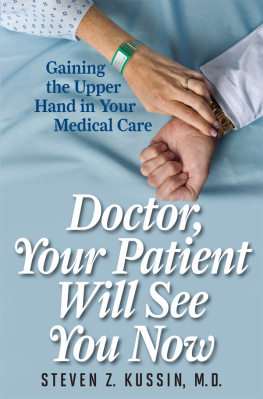

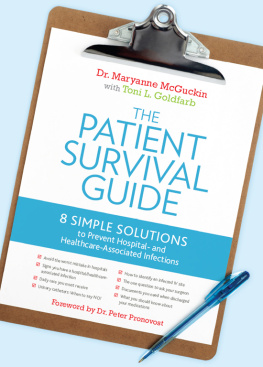
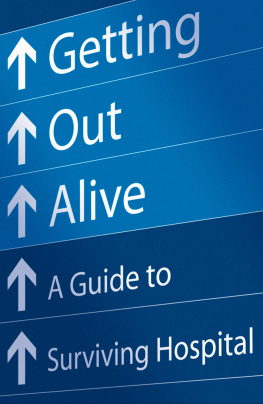
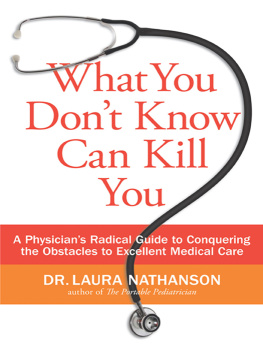
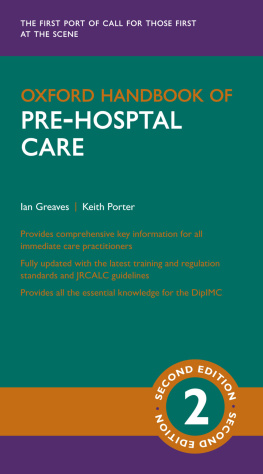
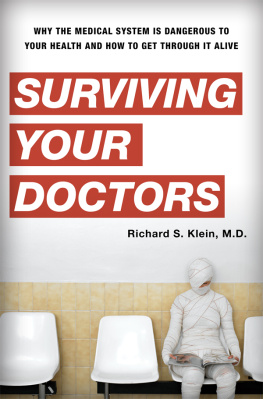
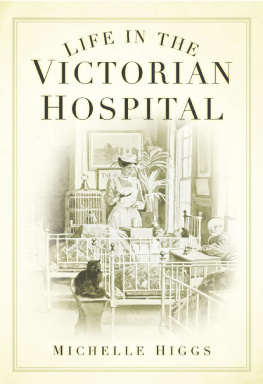
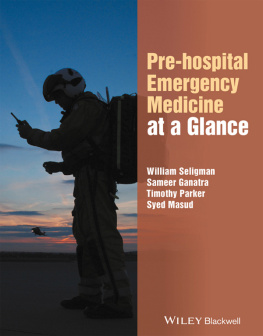
 The paper used in this publication meets the minimum requirements of American National Standard for Information SciencesPermanence of Paper for Printed Library Materials, ANSI/NISO Z39.48-1992.
The paper used in this publication meets the minimum requirements of American National Standard for Information SciencesPermanence of Paper for Printed Library Materials, ANSI/NISO Z39.48-1992.